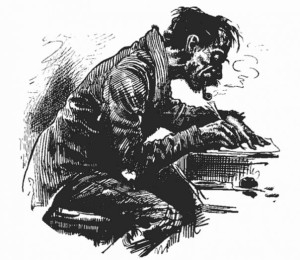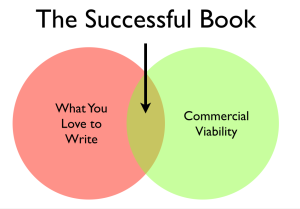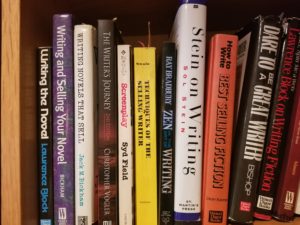by James Scott Bell
@jamesscottbell

John Gilstrap, r., with aspiring writer
Had a great last week with Mrs. B. We traveled back east to visit my big brother, whom I hadn’t seen in years. We also visited some old friends. Our final stop was at a house in the woods of West Virginia, where a writer named Gilstrap and his lovely wife Joy make their home, along with guard dog Kimber. As we relaxed and chatted, listening to the breeze in the trees (as opposed to the sirens on the streets), the talk naturally turned to writing. One of the topics was the perennial question: Can someone learn to write a novel by studying the craft?
You all know my answer to that, because that was my experience. I related that it was something I read in Jack Bickham’s book Writing Novels That Sell that set off paparazzi light bulbs going off in my head. It had to do with what a scene is, and especially how to end it so a reader must turn the page.
Now, a scene has three component parts: Objective, Obstacles, and Outcome.
Objective
A novel is about a character using strength of will to attain a crucial objective. For example, in The Fugitive, the wrongly convicted Dr. Richard Kimble must avoid being captured, or he’ll be sent to Death Row for a murder he did not commit. To exonerate himself—and get justice for his murdered wife—he needs to stay free long enough to find the one-armed man who killed her.
Each scene in the film has a sub-objective that connects to the big one. Thus, early on, the wounded Kimble has to sneak into a rural hospital and treat himself, without arousing suspicion. Later he poses as a janitor in a hospital in Chicago with the objective of gaining access to the records of the prosthetics wing. Why? So he can get a list of one-armed men to track down.
Obstacles
Conflict and tension are the lifeblood of a scene. When the viewpoint character is confronted with obstacles to gaining his scene objective—in the form of opposing characters, physical barriers, time pressure, or all three—things get tense.
In the rural hospital scene from The Fugitive, Kimble must sneak past the loading dock and find a treatment room. After stitching himself up, he needs to shave off his beard and steal some clothes. He does this in the room of a patient who is out like a light. But a nurse walks into the room! And a state trooper has arrived because Kimble might be in the area! The tension mounts as we worry about his cover being blown at any moment.
Outcome
A scene has to end at some point, and needs to answer the question: did the viewpoint character realize his objective?
Bickham lists four types of endings: Yes, Yes But, No, No and Furthermore!
A NO answer is always a good default, because it makes the character’s situation worse. When a character is set back in his quest, the reader’s worry mounts. And that is what readers want to do: worry about characters in crisis all the way to the end.
A YES needs to happen on occasion, but when it does, brainstorm how it can lead to more trouble, turning it into a YES BUT. For example, in the scene in The Fugitive where Kimble poses as a janitor, he is temporarily stuck on a crowded trauma floor. He spots a little boy in distress. When a doctor tells him to take the boy to an observation room, Kimble has a scene objective: Help this boy! As he pushes the gurney Kimble sneaks a look at the X-rays and the chart, and starts asking the boy diagnostic questions. He determines the boy needs surgery right away. In the elevator he changes the orders and takes the boy to an operating room. He alerts a doctor and shows her the orders. The boy will be saved! That’s a YES answer. However, his earlier look at the X-rays was seen by the doctor who asked him to help. She confronts him and calls security. Now Kimble is outed and has to get out of there! He’s in worse shape because of his good deed. That’s a big BUT to the YES.
The “but” in a YES BUT and the “furthermore” in a NO AND FURTHERMORE can also be a portentous question hanging over the proceedings, a hint of something worse yet to come. You leave the situation temporarily unresolved (a “cliffhanger”) and cut to another scene (perhaps with another viewpoint character). If you write in First Person POV or Limited Third Person (meaning one viewpoint character throughout the book) you can end a chapter on a cliffhanger and finish it up in the following chapter.
Now, to some aspiring scribes this might seem overly technical, perhaps with the reaction, “I don’t want to think about what I’m doing, I just want to do it!” Which is sort of like an apprentice plumber saying, “Don’t fill my head with how to use an augur, a pipe wrench, a drain inspection camera, or plumber’s putty. I’ve got my plunger, now get out of the way!”
Those few pages in Bickham’s book were easy to understand and put into practice. Which is when my fiction began to get favorable attention and, eventually, a publishing contract.
Bickham, like his mentor Dwight Swain, also writes of the “sequel” portion, which is generally about emotion (regarding the setback), analysis of what’s happening, and a decision on what to do next. But that’s a subject for another time.
And here is how you end a blog post: Comments are open.

 I love the writing craft. I love it the way
I love the writing craft. I love it the way 
 What’s wrong with this sentence, from an old pulp novel:
What’s wrong with this sentence, from an old pulp novel: The other morning, as is my wont (and I want what I wont when I want it) I took a fresh cup of joe and my AlphaSmart to the backyard for some thinking, pondering, and writing time. The joe was brewed in my moka pot, a gift to mankind from the Italian inventor Alfonso Bialetti. Usually I take it black, but we happened to have some Coffeemate Sweet Italian Cream in the fridge. I thought the key word was Italian, but as it turns out the emphasis should be on sweet. This stuff is a sugar bomb. You need less than a dollop of regular cream. My hand trembled, and I poured in a touch too much.
The other morning, as is my wont (and I want what I wont when I want it) I took a fresh cup of joe and my AlphaSmart to the backyard for some thinking, pondering, and writing time. The joe was brewed in my moka pot, a gift to mankind from the Italian inventor Alfonso Bialetti. Usually I take it black, but we happened to have some Coffeemate Sweet Italian Cream in the fridge. I thought the key word was Italian, but as it turns out the emphasis should be on sweet. This stuff is a sugar bomb. You need less than a dollop of regular cream. My hand trembled, and I poured in a touch too much.
